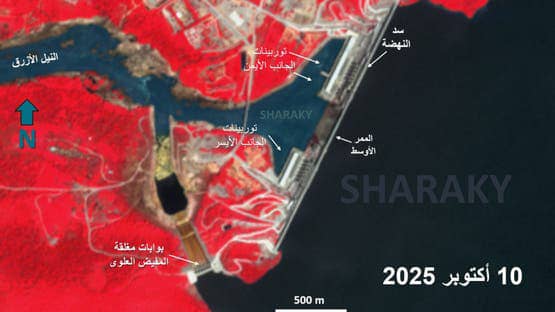Satellite images reveal new developments in the Ethiopian Renaissance Dam and rekindle flood fears

Satellite images have revealed new developments in the operation of the Ethiopian Renaissance Dam, amid mutual accusations between Addis Ababa on one hand, and Khartoum and Cairo on the other, regarding the Ethiopian administration of the dam causing recent floods that affected Sudan and Egypt. Experts have reiterated their warnings about the risks of unilateral filling on the physical and water security of the downstream countries.
Dr. Abbas Sharaki, a professor of water resources at Cairo University, revealed an analysis of satellite images showing that all spillway gates of the dam were closed, leading to a daily water inflow reduction to about 50 million cubic meters.
Sharaki stated in press remarks: "I found slight whirlpools that do not reach the operation of a single turbine, which means that part of the current rainfall, which reaches 250 million cubic meters, is being re-stored".
The water resources professor warned of the continuation of "confusion in the management of the dam's operation", pointing out that "the status of the turbines in operation remains unclear". He added: "Sudan is paying the price for operational mistakes", calling for "the complete discharge of the current rainfall amounts either through the turbines or by opening a gate from the upper spillway". He also warned that "filling the reservoir to its maximum by the end of this month raises new fears of further floods".
For his part, Dr. Mohamed Nasr Allam, former Egyptian Minister of Irrigation, highlighted the strategic risks of the dam, blaming the Ethiopian refusal to sign a comprehensive agreement. Allam said: "Ethiopia refuses to sign an agreement for the filling and operation of the Ethiopian dam that achieves Ethiopian goals of development and electricity generation on one hand, and preserves the water security of the downstream countries on the other".
He explained that "Egypt's greatest fear from the dam's repercussions will be during periods of drought and extended drought, due to Ethiopia's retention of a large water stock". He pointed out that "Ethiopia prefers to release limited amounts of water from the dam and retain a large water stock to maximize the height of the stored water column in the dam to maximize electricity production during drought periods, which may harm Egyptian water security".
The recent developments are linked to a wave of floods that have hit the region. According to Dr. Mohamed Nasr Allam, the Ethiopian administration of the dam after its inauguration contributed to exacerbating the problem. He said: "What happened before and after the dam's inauguration, with the discharge of minimal water rates during August and the beginning of September, then filling the dam's capacity designated for emergency floods, and using the emergency spillway to discharge water in a showy manner to satisfy the Ethiopian interior was a problem".
He added: "This coincided with high rainfall rates on the Blue Nile, and an increase in the river's inflow beyond its natural rates, especially since the dam is full of water, which forced Ethiopia to discharge all incoming water amounts to the dam, which reached about 750 million cubic meters daily, causing the floods that Sudan suffered from and leading to the drowning of its agricultural lands and the flow of water towards Egypt".
He revealed the emergency measures taken by Egypt to face this wave, saying: "In response to that and to confront and absorb the water coming from the floods, Egypt opened the Toshka spillway to discharge most of the water, causing damage to some existing crops and the flow of excess water towards some oases". He clarified that "Egypt discharged the little remaining through the openings of the High Dam, and there were some losses resulting from the flooding of about 1000 acres of relatively low-lying riverbank lands compared to the river's bridge level".
Sudan recently experienced a wave of floods that threatened residents and farmers, prompting the Sudanese Ministry of Irrigation and Water Resources to warn citizens living along the Nile to "take necessary measures to protect their property and lives".
In Egypt, the village of Delhamo in the Monufia Governorate was affected by flooding, and 4 other governorates declared a state of emergency in anticipation of rising water levels.
The Egyptian Ministry of Water Resources and Irrigation commented on the events, describing the Ethiopian actions as "reckless unilateral actions in managing its illegal dam in violation of international law". The ministry added in a statement that "these practices lack the most basic rules of responsibility and transparency, and represent a direct threat to the lives and security of the downstream countries' populations".
Estimates, according to Dr. Abbas Sharaki, indicate that "the rainfall rate in the Blue Nile basin is gradually decreasing, and will reach 150 million cubic meters by the end of October, and 50 million cubic meters by the end of November". This places the dam management issue in a new phase, between continued filling and water discharge, amid warnings of repercussions that may last for years to come.